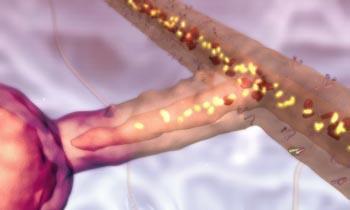A molecular imaging agent that can track the progress of tumour growth is about to be trialled in the UK.
A molecular imaging agent that can track the progress of tumour growth is about to be trialled in the UK.

GE Healthcare has developed a small peptide molecule to monitor tumour angiogenesis - the growth of blood vessels that supports tumour growth. The details of the molecule remain closely guarded, but it works by binding with a receptor on the surface of growing blood vessels.
The molecule will be used as a positron emission spectroscopy (PET) agent to follow angiogenesis in cancer patients, and to follow the response of tumours to drugs.
Don Black, head of research and development for GE Healthcare’s medical diagnostics division explained that the wealth of therapeutic products under development for angiogenesis led his team to develop the imaging agent. ’Primarily the idea is to be able to monitor therapy. To see which patients are responding, and to be able to let them change medication as quickly and effectively as possible,’ said Black, ’We specifically went out to look for molecules that could label angiogenesis, knowing all the therapies that had been developed.’
PET can trace radio-labelled molecules, typically fluorine-18 labelled. These molecules accumulate in areas with increased metabolic rates, like tumours.
The agent is about to enter clinical trials in healthy volunteers at Hammersmith Hospital, London, UK. If successful, it will move into trials in patients.
Black estimates that GE has spent tens of millions of dollars on angiogenesis research; a fair proportion of its annual research budget of over a billion dollars.
GE Healthcare is in early stage discovery collaborations with unnamed partners, and a number of pharma companies have expressed an interest for using the imaging agent in clinical trials, once the technology is proven. ’I’m happy to see all the therapeutics working out so well in this area, that gives us increased confidence about the ability to utilise this as a diagnostic,’ Black told Chemistry World. Black is confident of getting an oncology imaging agent onto the market. ’We want to really lead the way for therapeutics in the future,’ he said.
The work is applauded elsewhere ’Angiogenesis is a key process in tumour development,’ said Josephine Querido, cancer information officer at Cancer Research UK . ’Being able to visualise this in real time in patients would be an important step forward and could have important implications for how the success of cancer treatment is monitored in future. We look forward to the results of this clinical trial’
Developments in other areas, including neurology and cardiology, are now underway for the PET technology, said Black.
Katharine Sanderson






No comments yet